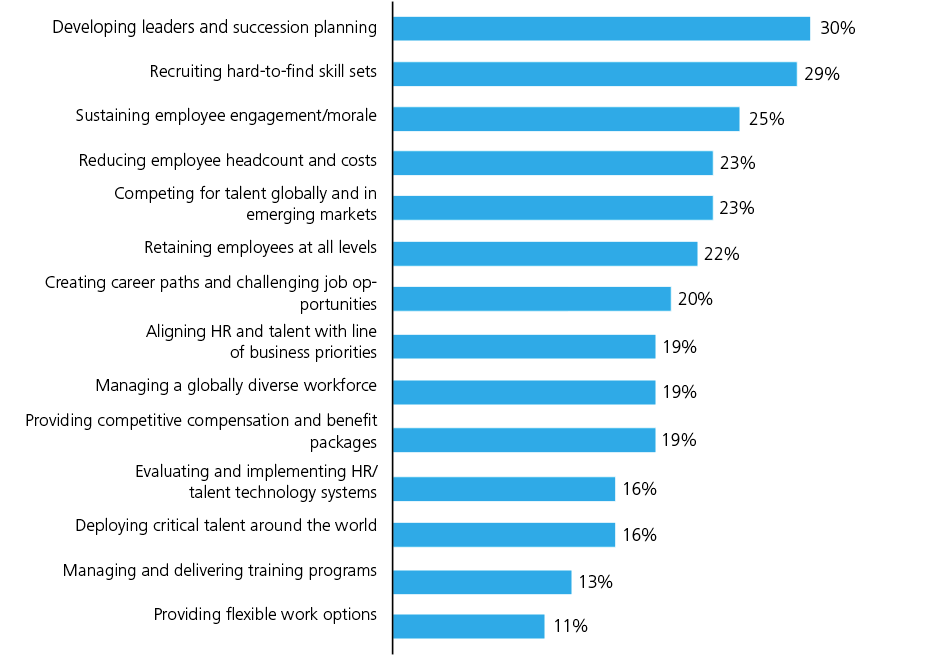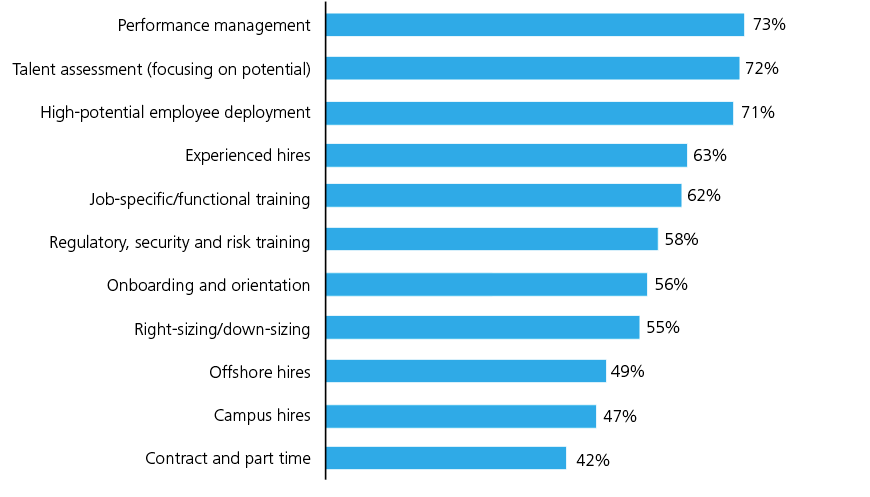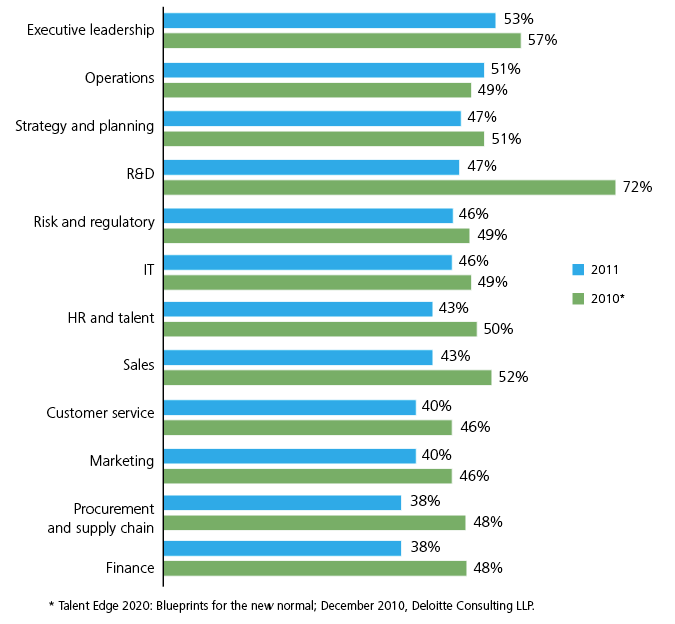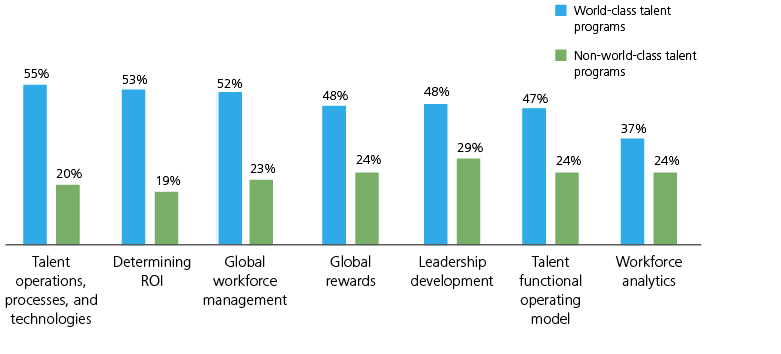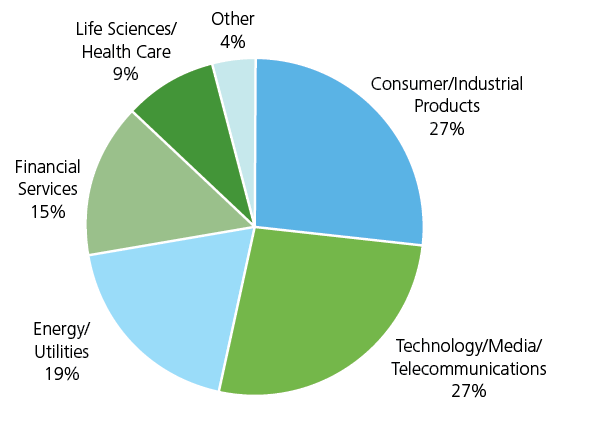Talent Edge 2020: Redrafting Strategies for the Uneven Recovery has been saved

Talent Edge 2020: Redrafting Strategies for the Uneven Recovery
02 January 2012
The latest edition of our survey series, Talent Edge 2020, builds on the findings of the previous two reports. As economic growth revs and sputters, leadership development and succession planning emerge as key concerns. Thirty-eight percent of the surveyed executives agree that growing top-and bottom line is a priority, and 33 percent say expanding into new markets is important. But to do that, companies will need leaders capable of steering their companies on both scale (efficiency and cost) and focusing on regional markets.
Many companies are seeking new sources of growth in a stalled economy.
As the economic recovery stalls and economists debate the likelihood of a double-dip recession, surveyed senior executives worldwide focus on seeking out new markets for growth in order to bolster both top- and bottom-line performance.
- Asked to rank their top strategic priorities, 38% of the executives surveyed listed improving top- and bottom-line performance, followed by expanding into global and new markets at 33%.
Survey respondents anticipate greater shortages in executive leadership over the next several years than in any other talent category in their companies—and also rank leadership as their most pressing talent concern.
Many executives are looking to strengthen their leadership development pipelines and programs.
Survey respondents anticipate greater shortages in executive leadership over the next several years than in any other talent category in their companies—and also rank leadership as their most pressing talent concern. Companies are exploring new accelerated leadership development programs to overcome expected shortfalls in leadership positions.
- Approximately a third (30%) of the executives surveyed ranked developing leaders and succession planning as today’s top talent priority—the highest percentage for any response in the survey. A nearly equal percentage (29%) predict it will likely remain the top talent concern over the next three years.
As talent demands go increasingly global, pressure is building to create talent strategies that can both scale (for size and efficiency) and focus on regional markets.
A significant percentage of the executives surveyed predict talent shortages over the next year, but the areas of greatest need vary widely by region. This dual emphasis on scale and focus is more important than ever as companies seek to exploit the global reach and cost efficiencies of talent systems and processes while focusing on unique challenges in regional and country markets.
A significant percentage of the executives surveyed predicted talent shortages over the next year, but the areas of greatest need vary widely by region.
- Surveyed Asia Pacific (APAC) executives face urgent needs, with significant shortages anticipated in research and development (R&D) (68%), operations (64%), and strategy and planning (62%). Survey participants in the Americas saw executive leadership and operations as the main talent gaps (both 56%), while business leaders in the Europe, the Middle East, and Africa (EMEA) region were far less concerned about shortfalls in talent.

Many corporate talent programs fall short on performance and investment.
Many business leaders at the companies surveyed see the need for significant improvement in key areas across their talent management programs. Executives who rated their talent programs as “world-class” also give higher ratings than their peers to both their capabilities and their levels of investment.
- Only 17% of the executives surveyed believed their talent programs were “world-class across the board,” while 83% acknowledged that significant improvements need to be made. Executives who call their talent efforts “world-class” were more likely to report—by margins of 20 percentage points or more—that their companies were investing in these programs at a “high” level.
Seeking new sources of growth in a stalled economy—and the talent to exploit new opportunities
As world economies teeter between hesitant growth and a return to recession, Deloitte’s analysis of the latest survey data suggests that many top corporate executives are increasingly looking for new avenues of growth, while keeping an eye on bringing costs into line with economic realities.
When asked to rank their top three strategic priorities, 38% of the executives surveyed listed improving top- and bottom-line performance—the highest management priority in the survey. Expanding into emerging and global markets ranked second among management priorities at 33%, while managing costs and acquiring/serving/retaining customers tied for third at 32%, followed by managing human capital at 30% (see figure 1).
Figure 1. Which top three strategic issues currently capture the most management attention at your company?
Digging deeper: Since Deloitte released its first longitudinal talent survey results in February 2009, the percentages of surveyed executives who report that their companies are focused on expanding into global and new markets have been steadily rising. As mature economies struggle with growth rates, the search for overseas opportunities has accelerated significantly (see figure 2).
Figure 2. Executives reporting that “expanding into global and new markets” is a top strategic priority
Strengthening leadership pipelines through innovative strategies
Given the increasing levels of economic uncertainty, perhaps it is not surprising that the current talent management environment, as evidenced by the responses to our survey, appears complex and defies easy categorization. Executives are focused on developing new leaders and succession planning, with 30% of the survey participants listing it as one of their top three pressing talent concerns—the foremost talent concern in the survey. Also vying for attention is recruiting employees with hard-to-find skills (see figure 3).
Figure 3. Organizations’ top three most pressing talent concerns in 2011
As expanding into new and global markets has moved up the management priority list, talent managers are rising to the challenge. Competing for talent globally and in emerging markets was named a top talent concern by nearly one in four (23%) executives surveyed. Asked to look forward three years from now, even more executives (27%) ranked global talent search as their top concern.
In an effort to identify and develop new leaders, create effective succession plans, and build global workforces, executives are aligning their talent management practices to meet these goals. In our survey, more than seven out of ten executives surveyed singled out performance management, talent assessment, and high-potential employee development as core talent priorities that are anticipated to increase over the next 12 months (see figure 4).
Figure 4. Organizations’ increasing focus on core talent management priorities over the next 12 months
This theme—an emphasis on developing the next generation of corporate leaders—appeared again when executives were asked to anticipate how their emerging talent management strategies were likely to change during the next 12 months. According to the executives who participated in the survey, over the course of the next year, many companies intend to focus on accelerated leadership development, with 40% of the survey respondents ranking it among the top three. This focus makes sense, as the goal of accelerated leadership development is to create a deep pipeline of potential leaders with capabilities that match each organization’s particular business needs. It also creates a strong talent brand that inspires employees and helps attract high-potential candidates from the outside.
71% of the survey respondents expressed “high” or “very high” levels of concern about retaining critical talent over the next 12 months, along with 66% who had the same concern about retaining high-potential talent.
Despite a persistently weak job market and high levels of unemployment, many executives are worried about the possible departure of potential leaders. Of the executives who participated in the survey, 71% expressed “high” or “very high” levels of concern about retaining critical talent over the next 12 months, along with 66% who had the same concern about retaining high-potential talent.
Generationally, executives and talent managers appear most concerned about retaining the future leaders of their companies. Nearly half of the respondents (47%) report “high” or “very high” levels of concern about Millennial employees departing for other firms, compared to 42% for Generation X employees and just 32% for Baby Boomers.
Since companies can easily match compensation packages, Deloitte believes companies can differentiate themselves in the talent marketplace by going beyond financial incentives and creating customized retention strategies that address issues such as career advancement and greater recognition.
Data from Deloitte’s April 2011 Talent Edge 2020 employee report makes it clear that employers are right to be concerned, since 65% of the employees surveyed were already looking for a new job or planning to look for a new job—but they may not have a handle on which employees they risk losing. The employers who participated in the January 2012 report were most concerned about losing employees from Generation Y. However, according to our April 2011 employee report, 72% of Generation X employees are already looking or plan to make their next career move, compared to 63% of Millennials.
Are companies taking the steps necessary to retain top employees? The evidence is mixed. Four in ten (40%) executives surveyed confirmed that their organization has an updated retention plan in place, and another 36% reported that an updated retention plan is in the works. However, only 30% of the executives surveyed were “very confident” about the overall effectiveness of their company’s retention strategies and programs.
Figure 5. Top three most effective retention initiatives by generation: Executives vs. employees
Our April 2011 employee report suggested that different generations have different goals, expectations, and desires—and organizations should tailor and target their talent strategies to satisfy each employee group from Baby Boomers to Gen Xers to Millennials. Surveyed executives appear to understand that different retention initiatives appeal to different generations. The only incentive ranked among the top three for all generational groups was additional bonuses/financial incentives (see figure 5). Since companies can easily match compensation packages, Deloitte believes they can differentiate themselves in the talent marketplace by going beyond financial incentives and creating customized retention strategies that address issues such as career advancement and recognition. In addition, organizations should focus on creating connections, as employees are more likely to stay in an organization where they feel connected to other employees, their manager, the organization’s purpose, and the resources they need.
Designing effective retention strategies begins with a clear understanding of employee goals and desires. However, there appears to be a disconnect between employers and employees in three areas:
- Intensity gap: Employers recognized that promotion/job advancement is a strong retention tool, but they appear to underestimate just how powerfully this incentive impacts all generations of employees. When it comes to Generation X, both employers and employees ranked promotion/job advancement at the top, but employees rate it 32 percentage points higher than their employers. For Generation Y, the intensity gap is eight percentage points (see figure 5).
- Employer-Boomer mismatch: Employers believe Baby Boomers are interested in additional benefits, additional bonuses, and flexible work arrangements. However, this generation is seeking more than just additional compensation and flexible schedules. According to our April 2011 report, Baby Boomers ranked promotion/job advancement as their top retention incentive at 50%; however, this incentive did not even appear among the top three in the employer survey. More than four in ten (43%) Baby Boomers surveyed also ranked increased support/recognition from supervisors as a key retention incentive—the only generational group to list this issue among the top three incentives.
Employers recognize that promotion/job advancement is a strong retention tool, but they appear to underestimate just how powerfully this incentive impacts all generations of employees.
- Money matters: Every generation of employees surveyed ranked additional compensation among the top three incentives for keeping them with their current employers. However, employers did not list additional compensation near the top for any generation—although they did see the value of additional bonuses or other financial incentives.
These findings suggest that executives may be exacerbating company pipeline issues by not focusing on the initiatives that can more effectively retain employees.
Five takeaways on leadership
Leadership represented a recurring theme throughout Deloitte’s January 2012 edition of Talent Edge 2020. As surveyed executives analyzed their existing talent plans to chart future strategies, their top concerns include the following five points:
Developing leaders and succession planning: Surveyed executives ranked developing leaders/succession planning as the top talent concern both today and three years from now.
Struggling to keep leadership teams intact: A majority of executives surveyed expressed concern about their organizations’ ability to retain company leaders.
Predicting leadership shortages: Across all talent areas, executives predicted the most severe shortages will likely occur in leadership, particularly in the Americas and EMEA.
Focusing on the leadership pipeline: Accelerated leadership development was rated the number one emerging talent strategy by the global executives who participated in the survey.
Closing the gap between priority and performance: Most executives surveyed rated leadership development a high priority at their companies, yet far fewer rated their leadership development capabilities highly.
Global talent plans challenged by regional needs
As many companies look overseas for growth, the competition for talent is increasingly global—a trend we first identified in the December 2010 edition of Talent Edge 2020. Analyzing the results of this new survey, it became apparent that companies should adapt their talent strategies and priorities to fit different global regions while also addressing the simultaneous challenge of scale. When surveyed executives were asked to forecast areas where they expect talent to be in short supply over the next year, where they were located had a significant influence on the talent they believe they will need, with APAC having greater shortages than both EMEA and the Americas (see figure 6).
Analyzing the results of this new survey, it became apparent that companies should adapt their talent strategies and priorities to fit different global regions while also addressing the simultaneous challenge of scale.
In the APAC region, more than half of the executives surveyed predict talent shortages across all 12 of the functional areas surveyed, with an overall average of 61%. The most pressing needs appear to be in R&D, where 68% of APAC executives foresee talent shortages, followed by operations and procurement and supply chain at 64%, and strategy and planning at 62% (see figure 6).
The shortages predicted by the APAC executives surveyed are in line with our April 2011 employee report. Asked if workers were already looking or planning to search for a new job in the next 12 months, a majority of the surveyed APAC employees—said “yes.”
Executives in the EMEA region appear to face far less pressing talent shortages than in APAC or the Americas, with an average of only 31% across the 12 functional areas (30 percentage points less than APAC). Nearly half (47%) of those surveyed in EMEA see potential shortages in executive leadership talent, but that was the only category that rose above 40% (see figure 6). In the Americas, surveyed executives anticipate significant talent shortages in executive leadership (56%), operations (56%), and IT (50%) (see figure 6).
Digging deeper: The talent required in the coming years will vary significantly by industry. These differences are especially pronounced in Energy/Utilities and Financial Services. For example, only 7% of respondents in the Financial Services industry believe they will have severe talent shortages in operations, while 37% of respondents in Energy/Utilities expect these shortages. Over two in three (67%) respondents in Financial Services expect slight-to-no shortages in marketing, compared to 57% in Energy/Utilities who expect moderate-to-severe marketing talent shortages.
Figure 6. Do you expect significant or moderate talent shortages in the following areas over the next year?
Regional differences were also reflected in projected hiring patterns over the next year, with APAC again showing the most vigorous talent market and aggressive hiring plans.
Over the next 12 months, about three out of four executives surveyed in the APAC region expect to ramp up hiring across the board in virtually every organizational function. The hottest talent areas in the APAC region are anticipated to be operations, sales, and marketing. In each of these areas, more than 80% of executives and talent managers expect to hire additional employees during the next year.
In the Americas, 72% of the executives surveyed anticipate hiring additional employees in operations, along with 63% in IT and 62% each in sales and R&D. The hiring picture looks far bleaker in the EMEA region. The only categories in which more than four in ten executives surveyed planned additional hiring were sales at 45% and operations at 44%, according to the October 2011 data.
Digging deeper: Is R&D falling off the executive radar screen? In Deloitte’s December 2010 survey report, nearly three-quarters of executives (72%) forecasted talent shortages in R&D. These concerns seem to have eased—only 47% now say R&D will need a talent infusion in the next 12 months (see figure 7). This same trend was evident when we asked executives what strategic issues were at the top of their agendas. In 2010, 27% ranked R&D highly, compared to just 18% in 2011 (see figure 1). While R&D is typically a long-term play and the payoffs often do not come for years, many companies are being pressured to focus on short-term cost containment as well as revenue generation, given the uncertain economy. So if a company is looking to bolster its balance sheet, it may be sacrificing long-term R&D for short-term benefits.
Figure 7. Talent shortages comparison 2011 vs. 2010
Spotlight: Talent programs falling short, investment not up to the challenge
In each edition of Talent Edge 2020, Deloitte turns the spotlight on one key area of talent management in order to gain a more in-depth understanding of where companies are excelling and why. In our October 2011 survey, we asked executives to assess their capabilities across seven critical talent management initiatives and to rate both the level of importance and investment in each.
While most executives agree talent management programs are a high priority, many lack confidence in their capabilities to deliver the talent, skills, and leaders they need.
As Deloitte began to dig deeper, with questions about specific talent programs, three conclusions stood out:
- Most executives surveyed rated talent management programs a high priority;
- Many did not have a high degree of confidence in their capabilities to deliver on the required talent, skills, and leaders;
- Companies with self-assessed “world-class” talent programs see both their capabilities and committments differently from their counterparts at other organizations.
Many companies recognize the need to assemble, train, and retain a world-class workforce as they strive to prosper in an increasingly competitive global economy.
Yet, many executives appear to believe their talent management programs are not up to the challenge. Only 17% of the executives surveyed believe their overall talent management programs are “world-class”. More than four in ten (43%) described their talent management programs as adequate but in need of improvement, just getting by, or underperforming (see figure 8).
Figure 8. Self-assessment of overall talent management programs
Talent management priorities.
Breaking the numbers down individually by priority, capability, and investment level sharpens the picture. Corporate emphasis on leadership development programs was a recurringa theme throughout this survey, so perhaps it is not surprising that 53% of the survey participants rated it a “high” priority at their companies—the top choice among the seven talent management initiatives (see figure 9).
Interestingly, surveyed executives who called their organizations’ talent management programs “world-class” had a vastly different sense of which programs were more important for their companies. While 56% agreed that leadership development is important, executives at these “world-class” companies ranked every other priority higher (see figure 10). In Deloitte’s view, these findings suggest that “world-class” companies have already focused on developing their leadership pipelines and are turning their attention to new priorities, such as workforce analytics and talent function operating models.
Figure 9. Percent of respondents rating talent priority, capability, and level of investment as “high”
Figure 10. Importance of priority area is “high”: World-class talent programs vs. non-world-class talent programs
Talent management capabilities.
Do talent management priorities align with corporate capabilities? Not according to our survey data. When it comes to leadership development, for example, 53% of the executives surveyed rated leadership programs a “high” priority, yet only 33% believe they have “high” capabilities in this area (see figure 9). We believe that organizations looking to “raise their talent management game” in order to better attract and retain employees may want to start with improving their leadership development programs.

Of the executives who regarded their talent programs as “world class,” 53% rated their leadership development capabilities highly, compared to just 28% of other respondents—a 25-point gap.
Perhaps not surprisingly, many companies with self-identified “world-class” talent programs had significantly more confidence in their capabilities across all seven talent areas. Of the executives who regarded their talent programs as “world-class,” 53% rated their leadership development capabilities highly, compared to just 28% of other respondents—a 25-percentage-point gap (see figure 11).
Digging deeper: Depending on whether their company has experienced layoffs in the past six months, there are some notable differences in the ways executives think about their organizations’ talent areas. For surveyed executives who have seen recent layoffs, almost half (48%) rated their talent function operating model as a high priority. For those who have not experienced layoffs, this drops to just over a third (37%). Also, at organizations that reported layoffs, almost half (47%) the executives rated workforce analytics as a high priority, while just one in three (33%) rated it as highly in organizations that have not experienced layoffs.
Figure 11. Capability in priority area is “high”: World-class talent programs vs. non-world-class talent programs
Talent management investment.
In addition to inquiring about talent priorities and capabilities, Deloitte asked executives to rate the level of investment their companies are making. In each instance, the gap between talent program priorities and investment was at least 10 percentage points, with the biggest gap appearing in leadership development (see figure 9).
Comparing those companies with “world-class” talent programs against their competitors proved to be an interesting benchmarking exercise. By significant margins—often 20 percentage points or more—surveyed executives who rated their talent programs as “world-class” also reported a “high” level of investment in these initiatives (see figure 12).
Leadership checklist
Based on Deloitte’s research on leadership,* some of the key steps organizations can take into consideration when planning and implementing leadership development programs include:
- Aligning leadership strategy with business strategy in order to measure individual and organization success consistently
- Creating a clear leadership capability framework so the organization has a defined picture of what a future senior leader needs to do well
- Recognizing that leadership potential is different from current performance—and learning how to spot and assess for potential using objective criteria
- Putting decision rights and governance in place for developmental job moves by high-potential individuals
- Creating high-impact programs to accelerate on-the-job development and the formation of critical support networks
- Ensuring senior leaders are setting the right example, including being “hands-on” in leadership development programs
* Source: Deloitte’s Leadership by design: An architecture to build leadership in organizations, Deloitte Consulting, 2011.
Figure 12. Investment in priority area is “high”: World-class talent programs vs. non-world-class talent programs
The bottom line
What a difference a year makes …
2011 began with the prospect of an imminent global recovery and ended with the specter of a double-dip recession that threatened to create a long and uneven global recovery. The standout findings from the latest edition of Deloitte’s Talent Edge 2020 series are twofold: the near-universal agreement about the existing and potentially growing shortage of executive leadership and the significant regional differences in talent needs around the globe. The world may now be one economy, but it is definitely not one talent market.
The world may now be one economy, but it is definitely not one talent market.
According to the majority of executives surveyed for this report, current corporate leadership development programs are not capable of meeting the challenge ahead. Surveyed executives report that their companies are not investing the resources necessary to develop new leaders. Looking to the future, in order to thrive, not just survive, we believe executives should ask themselves three critical questions:
- Where can we find opportunities for growth in an uncertain economy that is recovering at different rates in different regions?
- Do we have the right talent in the right places to leverage those opportunities?
- Do we have the talent and leaders—and the required talent programs—to weather the economic, technological, and regulatory challenges ahead?
Ultimately, building world-class talent programs requires investment. Our research has shown that while fewer than one in five surveyed executives identified their organizations as “world-class” in talent, more than four in five acknowledge the need for significant improvements and investments. The organizations that report they are “world-class” in talent are not sitting back and waiting for a slow recovery to solve their talent challenges. These executives are more likely to invest (by a 2:1 margin) across the board in talent priorities and initiatives. These talent leaders are taking responsibility for their future and focusing investments and capabilities on their top priorities. They are getting down to rebuilding and developing new talent programs for leaders and critical employees. In short, self-assessed “world-class” companies are putting their money on the table and investing in talent priorities and programs.
Survey demographics
In the latest report of Deloitte’s Talent Edge 2020 longitudinal study, Forbes Insights surveyed 376 senior executives, 66% of whom held board, CEO, CFO, CHRO, or HR/talent director positions (see figure 13).
Figure 13. Which of the following describes your title?
As figure 14 shows, all survey respondents were employed by companies with annual revenues of more than $500 million. More than eight in ten (82%) work for companies that earn more than $1 billion in revenues and 34% report their companies generate revenues higher than $10 billion.
Figure 14. Company revenues during the most recent fiscal year
As shown in figure 15, participating executives are spread across the world’s three major economic regions: 38% in the Americas; 34% in Europe/Middle East/Africa; and 28% in Asia Pacific. Survey participants represent a broad set of industries (see figure 16), including Technology/Media/Telecommunications (27%), Consumer Industrial Products (27%), Energy/Utilities (19%), Life Sciences/Health Care (9%), and Financial Services (15%).
Figure 15. Respondents by location
Deloitte’s Talent Edge 2020 longitudinal study will continue to track the shifts in talent strategies, trends and priorities in the months ahead. The next edition of the study will be published in the spring of 2012 and will focus on employees.
Figure 16. Company industries
© 2021. See Terms of Use for more information.



